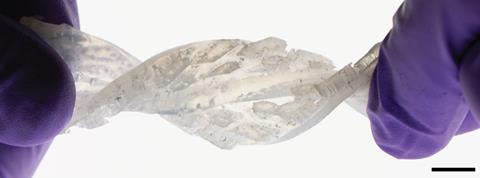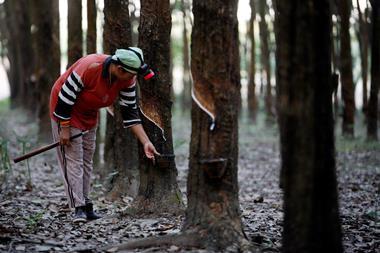Strategically embedding rigid particles around long polymer chains can dissipate stress in rubber and increase the fatigue threshold sixfold, researchers in the US have shown. This potentially opens a ‘new paradigm’ for the design of stiff, fatigue-resistant rubbers in applications such as textured belts, tyre treads and soft robotics.
A filled rubber is a composite material held together by a matrix of elastic polymer chains and stiffened by rigid particles such as carbon black or silica. The filler material can increase the elastic modulus of the rubber by two orders of magnitude, making composite materials extremely useful for applications like tyres. It does not, however, significantly increase the fatigue threshold (the cumulative amount of energy the material can absorb over repeated deformation cycles before failing).
In a traditional filled rubber, the rigid particles do not strongly bond to the polymer chains. Researchers at Harvard University investigated the effects of changing this using a long-chain, highly entangled poly(ethyl acrylate) polymer (PEA) filled with silica nanoparticles. When the nanoparticles were functionalised with trimethylsilyl groups, which did not bond to the polymer chains, the fatigue resistance was the same as that of the unfilled polymer. However, 3-(trimethoxysilyl)propyl methacrylate functional groups formed strong interlinks between the silica nanoparticles and the polymer chains. Switching the functional group therefore allowed the entanglements between the interlinked chains to store energy in a flexible, net-like structure. This change more than doubled the fatigue resistance.

The researchers then increased the volume of the particles in the composite from 15% to 45%. This allowed particles to cluster together more closely and enabled the resulting composite to ‘deconcentrate’ stress at two different scales: if one polymer chain between two particles failed, the stress could be dissipated in the others without the two particles breaking apart; and if the two particles did break apart, the stress could then be transferred to links between other particles without the polymer failing. The cumulative effect increased the fatigue threshold to six times that of unreinforced PEA.
The researchers demonstrated the usefulness of their composite by producing a mechanical gripper for soft robotics using kirigami – a variation of origami where structures are folded and cut. This is demanding because high elastic modulus is necessary for the gripper to lift large loads and a material with low fatigue threshold will fracture under repeated cycles of deformation as the crack propagates. The researchers report that, whereas a highly crosslinked polymer fractured after only a few cycles, their material could lift six times the mass of the unreinforced PEA, yet showed negligible deformation after 350,000 cycles.
‘I think this paper really brings a new paradigm for thinking about lifetime in soft materials like rubbers,’ says Gabriel Sanoja at the University of Texas at Austin. He says that the idea ‘of designing the architecture of a material to be efficient at delocalising stress seems to be gaining momentum in the literature’ so he expects the paper will lead researchers to explore other questions. ‘How do you really go about this rationally? How do you really exploit chemistries to take advantage of this principle and then maybe even push the performance forward?’
References
J Steck et al, Nature, 2023, 624, 303 (DOI: 10.1038/s41586-023-06782-2)

















No comments yet